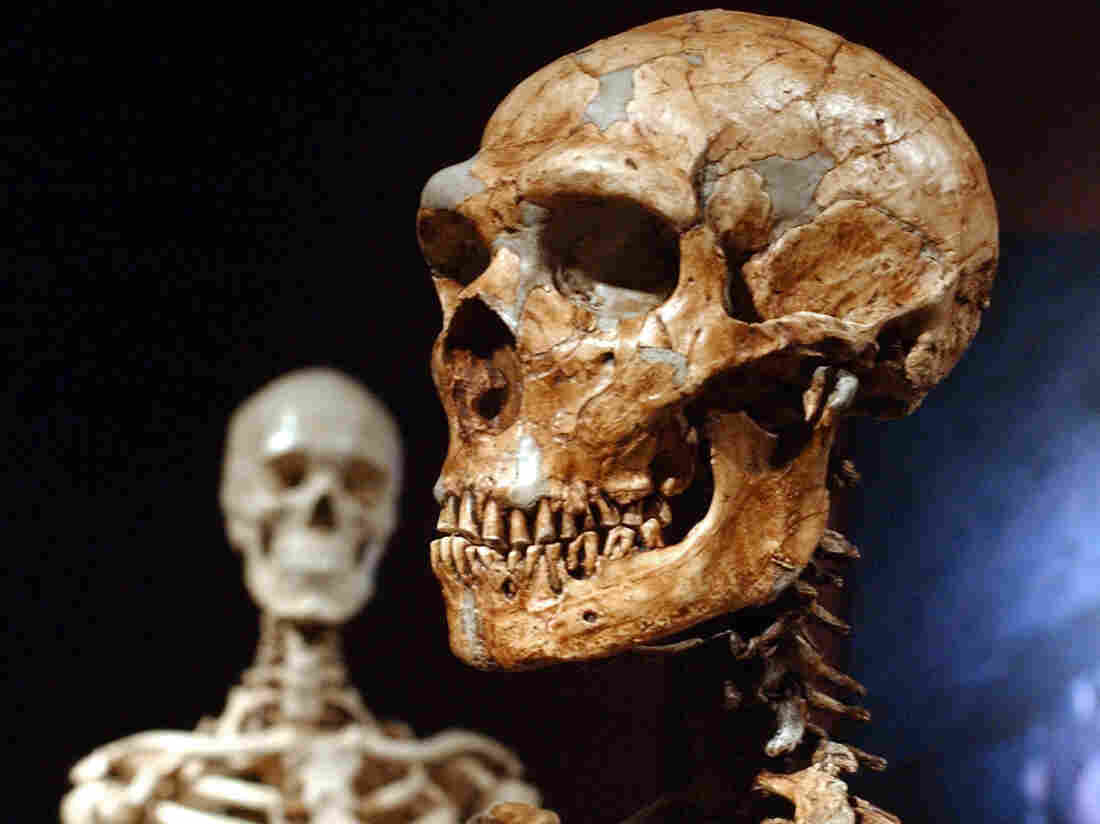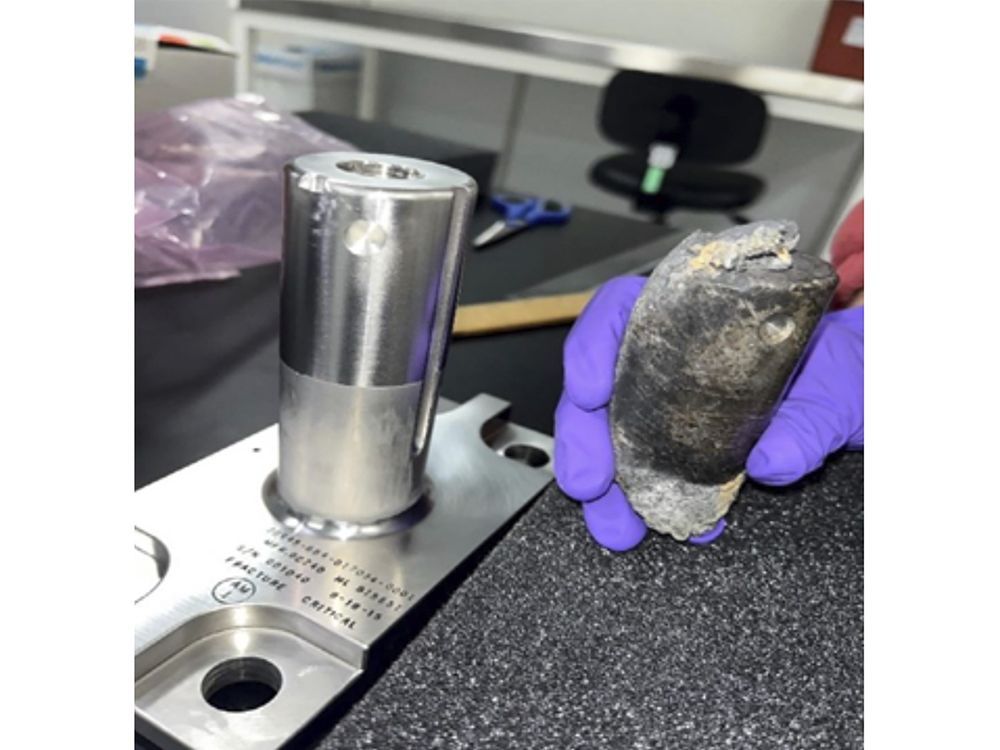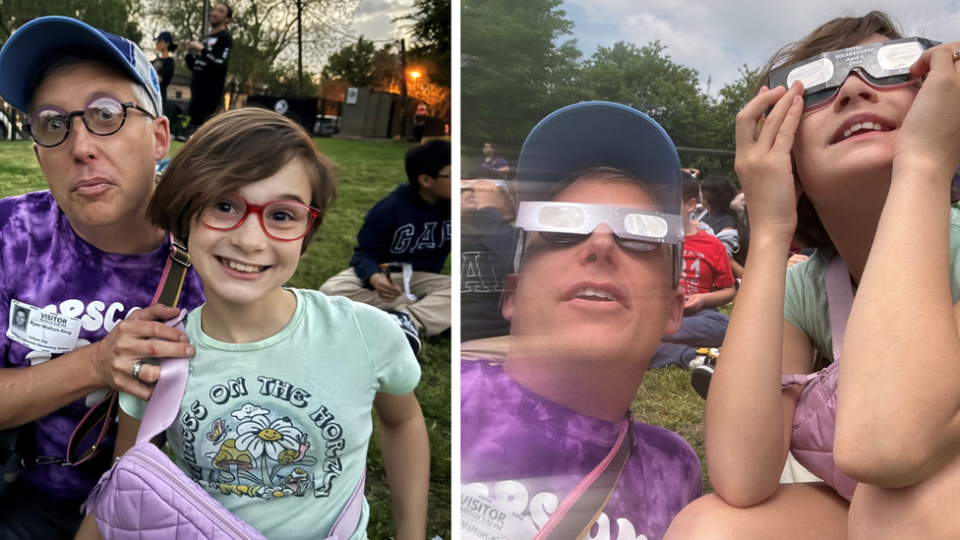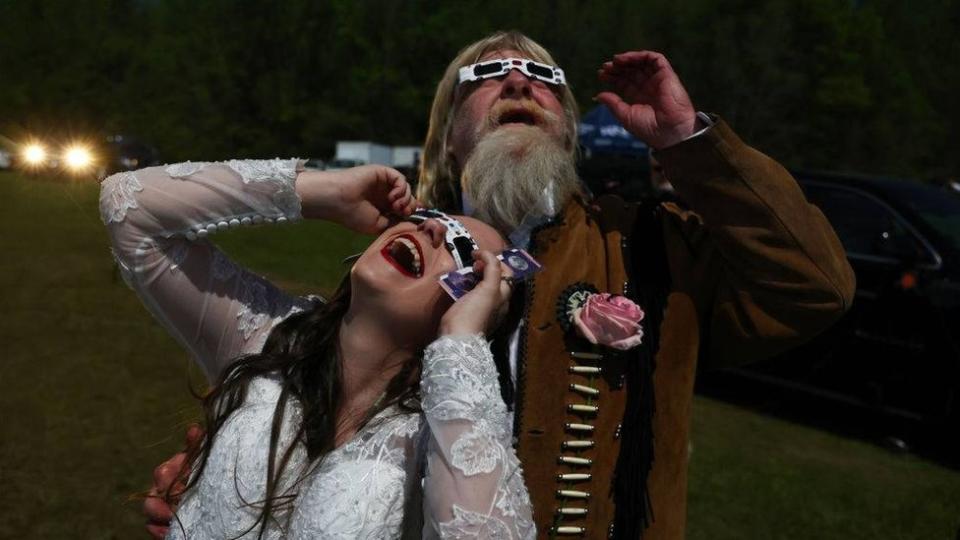Science
Cold Climates Correlate With Big Bodies For Human Ancestors – NPR


Big bodies are good for cold places.
That’s the gist of a foundational rule in ecology, which has been around since the mid-1800s: animals that live in colder places tend to have larger bodies, especially birds and mammals that need to regulate their body temperatures. For example, some of the largest whale and bear species have evolved in the coldest reaches of the planet.
The rule applies broadly to modern humans, too. Populations that evolved in colder places generally have bigger bodies.
That’s also true of human ancestors, a new study finds. The research offers conclusive evidence that human body size and climate are historically connected.
In general, our ancient relatives got much larger as they evolved. “Over the last million years, you see that body size changes by about 50 percent and brain size actually triples, which is a lot,” explains Andrea Manica, an evolutionary ecologist at the University of Cambridge. “And there have been all sorts of theories about what might have underpinned those two big changes in size.”
Manica and a team of paleontologists and climate scientists in Germany and the United Kingdom set out to test one of those theories: that the local climate was driving brain and body growth. They examined about 300 fossils of human ancestors collected in Europe, Asia and Africa, and used the same basic climate data that scientists use to predict future climate change to estimate instead temperature and precipitation over the last million years.
“We reconstructed climate back in time, so we could say what the climate was when that specimen was alive,” Manica says.
The researchers found that human ancestors and Neanderthals living in colder places generally had larger bodies. Past studies suggested this might be true, but didn’t assemble such broad evidence. For one thing, past research often relied on rough, global estimates of the past climate, whereas the new study estimates what each human ancestor would have experienced in their region.
The new findings are “reasonably convincing,” says Mark Collard, who studies human evolution at Simon Fraser University in Canada and was not involved in the study. However, he suspects that the new analysis may overstate the relationship between temperature and body size because of uncertainties in both the fossil record and the climate data.
The authors of the new study also found that the rapid increase in human brain size over the last million years was not strongly correlated with climate. “For brains, you need other explanations,” says Manica, perhaps such as diet or social structures.
For decades, scientists who study human evolution have posited that what our ancestors ate — whether it was cooked or raw, included meat or only vegetables — influenced how our brains evolved. It’s also possible that more complex social structures and group communication are linked to brain growth in human ancestors.
“I suspect that social factors such as group size are more likely to influence brain size,” Collard says.
Modern humans need not worry that the new findings about body size and climate will show up in our daily lives.
The Earth is getting steadily hotter due to human-caused climate change. But human body size will not shrink as a result, at least not in the near future.
That’s because it takes many, many generations for humans to evolve. The average human generation is about 30 years, so it would take hundreds or even thousands of years of sustained warming before human body size changed in reaction to global warming. And, even then, the changes would be very slight — about 1 kilogram per 2 degrees of warming, Manica says.
“We’re not going to shrink tomorrow,” he says. “That’s the good news. But climate change is problematic for many other reasons.”
Science
NASA is seeking a faster, cheaper way to bring Mars samples to Earth – CityNews Toronto


CAPE CANAVERAL, Fla. (AP) — NASA’s plan to bring samples from Mars back to Earth is on hold until there’s a faster, cheaper way, space agency officials said Monday.
Retrieving Mars soil and rocks has been on NASA’s to-do list for decades, but the date kept moving forward, as costs ballooned. A recent independent review put the total cost at $8 billion to $11 billion, with an arrival date of 2040, about a decade later than advertised.
NASA Administrator Bill Nelson said that’s too much and too late. He’s asking private industry and the space agency’s centers to come up with other options to revamp the project. With NASA facing across-the-board budget cuts, he wants to avoid gutting other science projects to finance the Mars sample project.
“We want to get every new and fresh idea that we can,” he said at a news conference.
NASA’s rover Perseverance already has gathered 24 core samples in tubes since landing in 2021 at Mars’ Jezero Crater, an ancient river delta. The goal is more than 30 samples to scour for possible signs of ancient Martian life.
The space agency wants to get at least some of the collected samples to Earth sometime in the 2030s for no more than the $7 billion. That would require a spacecraft that goes to Mars to get the tubes and launches off the planet. Then it must rendezvous with yet another spacecraft that would bring the samples to Earth.
NASA’s science mission chief, Nicky Fox, refused to speculate at the news conference when the samples might arrive at Earth, given a new program and timeline, or even how many samples might be returned. That information will be included in any proposals, she said.
“We’ve never launched from another planet, and that’s actually what makes Mars sample return such a challenging and interesting mission,” Fox said.
Scientists are eager to analyze pristine samples from Mars in their own labs, far superior to the kind of rudimentary testing done by spacecraft at the red planet. It will take such in-depth testing to confirm any evidence of microscopic life dating back billions of years when water flowed on the planet, according to NASA.
The samples will help NASA decide where astronauts go on Mars in the 2040s, Nelson said.
NASA’s Jet Propulsion Laboratory in Pasadena, California, had been in charge of the sample project. It was hit by hundreds of layoffs earlier this year due to all the budget cutbacks. Nelson is seeking ideas from across the space agency, with the revamped program more spread out.
NASA hopes to receive any ideas by late fall.
___
The Associated Press Health and Science Department receives support from the Howard Hughes Medical Institute’s Science and Educational Media Group. The AP is solely responsible for all content.
Marcia Dunn, The Associated Press
Science
NASA confirms mystery object that crashed through roof of Florida home came from space station – Toronto Sun


Article content
NAPLES, Fla. (AP) — NASA confirmed Monday that a mystery object that crashed through the roof of a Florida home last month was a chunk of space junk from equipment discarded at the International Space Station.
Article content
The cylindrical object that tore through the home in Naples on March 8 was subsequently taken to the Kennedy Space Center in Cape Canaveral for analysis.
Article content
The space agency said it was a metal support used to mount old batteries on a cargo pallet for disposal. The pallet was jettisoned from the space station in 2021, and the load was expected to eventually fully burn up on entry into Earth’s atmosphere, but one piece survived.
The chunk of metal weighed 1.6 pounds (0.7 kilograms) and was 4 inches (10 centimetres) tall and roughly 1 1/2 inches (4 centimetres) wide.
Homeowner Alejandro Otero told television station WINK at the time that he was on vacation when his son told him what had happened. Otero came home early to check on the house, finding the object had ripped through his ceiling and torn up the flooring.
“I was shaking. I was completely in disbelief. What are the chances of something landing on my house with such force to cause so much damage,” Otero said. “I’m super grateful that nobody got hurt.”
Share this article in your social network
Science
Total solar eclipse: Continent watches in wonder – Yahoo News Canada
Across Mexico, the US and Canada, inside a ribbon of land stretching 155 miles wide but more than 4,000 miles long, tens of millions of people craned their necks, tilted their heads to the sky and watched in wonder as the day turned to night.
What many saw on Monday was a phenomenon like no other: the Moon moving between the Earth and the Sun, extinguishing its light in a total solar eclipse.
The path of totality spanned the continent, beginning over the warm sands of a Mexican beach town and darkening the skies above the crashing waters of Niagara Falls before ending its journey on the shores of Canada’s Newfoundland.
It left a sense of awe in its wake, a reminder of our planet’s place in the universe.
The eclipse was first seen around Mazatlán, Mexico, on the country’s western shores at 11:07 local time (18:07 GMT).
At first, the Moon’s outer edge seemed to just be touching the Sun. Then it devoured more and more until cheers erupted as all finally went dark – save for the silvery glow of the “corona” effect of the Sun around the Moon’s outline.

A thousand miles away in Dallas, Texas, 11-year-old Ady Walton-King was waiting, weeks of pent-up excitement ready to burst.
She had learned all about the eclipse in her fifth-grade class at Dallas Academy and on Monday morning she laced up her shoes and tucked four pairs of eclipse glasses into her pink purse – one for herself, one for each parent and one for her little sister, Abigail.
Just before it started, Ady sat down beside her dad, Ryan, on a school field in central Dallas and lifted her gaze upward.
And then it happened.
It all felt slow, she said, as she described the Texas afternoon turning dark. “It looked like the Moon was biting the Sun, but without the teeth marks.”
Clouds slid in and out, occasionally blocking the eclipse from view until the Sun had vanished, nothing left but little flares of light around the Moon.
“I didn’t think it would be like that,” Ady said. “It was really dark out. I thought it would be like evening dark, but it was pretty close to pitch black.”
The temperature dropped suddenly and, just as she had been taught, animals fell silent.
“As it started to get lighter the crickets were there, and the birds started singing. It was really crazy,” she said. “I’m sad it’s over.”
From there, the eclipse moved on, carving its path north-east through the United States.
For some, the solar phenomenon was marked by a personal milestone, with hundreds of Americans joining one of several mass wedding events dotted across the path of totality.


In Russellville, Arkansas, 300 couples from across the country signed up, saying “I do” just before the sky went black. As the sky brightened, the group cut wedding cakes and danced – all part of the aptly named Total Eclipse of the Heart festival.
Following the Moon one state over, in Ellsinore, Missouri, was amateur astronomer Darcy Howard, who had driven from her home in central Arkansas to be sure bad weather didn’t block her view.
She had seen many eclipses before today, two totals, one annular and two partials. “Each one has its own fingerprint,” she said.
Totality today, at around 13:56 local time (18:56 GMT) brought an “eerie twilight”, Ms Howard said, with dusky colours dotted all along the horizon. The corona was nearly as bright as a full moon. “The sense of other-worldliness was all around,” she said.
The 70-year-old has loved the cosmos since her childhood, since her father showed her the Big Dipper, the North Star and the Milky Way, and bought her her first telescope.
“I was hooked,” she said. “I can look through a telescope and see Jupiter… I can see Saturn. And when I see that in space, I know all is right with the world.”


By 15:13 local time (20:13 GMT), the total eclipse had plunged the midwestern state of Ohio into darkness.
In Cleveland, where eclipse-watchers were graced by clear skies, the Sun’s corona was clearly visible, a brilliant halo framing the Moon.
The stars came out in the middle of the day, a sight met with cheers and fireworks, a mid-April New Years Eve.
Many big American cities were not lucky enough to be on the path of totality – but the spectacles were still awe-inspiring. In New York, hundreds of people crowded on to the viewing platform of the Edge skyscraper in Manhattan to see what they could see.
They did not leave disappointed as the sun shrank to a crescent-like sliver of light that cast an unearthly pale gloom over the city.


Tourists had crowded along both sides of the border at Niagara Falls, where the eclipse path crossed from the US into Canada.
Here, the weather offered a formidable challenge, with thick grey clouds mostly obscuring the sky from view.
But just in time for totality – to the audible delight of the crowd – the clouds parted to reveal the black-hole Sun.
Nearby, on a Niagara City Cruise, 309 people celebrated by record-breaking – dressing up as the Sun to break the Guinness World Record for “Largest gathering of people dressed as the Sun”.
The relentless motion of the heavenly bodies meant that the phenomenon did not last long, and it was Montreal that next got its chance to be plunged into temporary night.
In Montreal, 20,000 people crowded onto a field on McGill University’s campus for an event held by the school’s Trottier Space Institute.
“We had been expecting 8,000,” programme administrator Caroina Cruz-Vinaccia said after. The weather was perfect, clear and bright skies. At the moment of totality, the crowd erupted at once, she said.
“I still can’t quite find the words for how cool this was,” she said. “We’re still coming down.”
Crowds were smaller on Newfoundland’s Fogo Island, on Canada’s east coast – one of the last places the totality could be viewed.
Bethany Downery, a Newfoundland native who works for the European Space Agency, tuned into the spectacular view from the Fogo Island Inn, nestled right against the Atlantic Ocean.
The skies were overcast, she said, but the clouds moved miraculously in time to catch near totality.
And with that, a day of collective wonder and celebration reached its conclusion. But it had left a permanent mark on many of those who had witnessed it.
In Dallas, a few thousand miles back along the path, Ady Walton-King was making plans.
Texas will not be in the path of totality again for another 300 years, so she’ll have to travel for the next one in North America, in 2044.
And by that time, she’ll be even more of an expert on total eclipses. “I want to be a scientist by the time that happens,” she said.
– With additional reporting from Brandon Livesay, Nada Tawfik, Nadine Yousif and Helena Humphrey


More on the solar eclipse
-
Media21 hours ago
DJT Stock Plunges After Trump Media Files to Issue Shares
-
Business20 hours ago
FFAW, ASP Pleased With Resumption of Crab Fishery – VOCM
-
Media20 hours ago
Marjorie Taylor Greene won’t say what happened to her Trump Media stock
-
Business21 hours ago
Javier Blas 10 Things Oil Traders Need to Know About Iran's Attack on Israel – OilPrice.com
-
Art22 hours ago
It’s Time to Remove Father Rupnik’s Art – National Catholic Register
-
Media19 hours ago
Trump Media stock slides again to bring it nearly 60% below its peak as euphoria fades – National Post
-



 Politics20 hours ago
Politics20 hours agoIn cutting out politics, A24 movie 'Civil War' fails viewers – Los Angeles Times
-
Real eState14 hours ago
Real estate mogul concerned how Americans will deal with squatters: ‘Something really bad is going to happen’ – Fox Business





